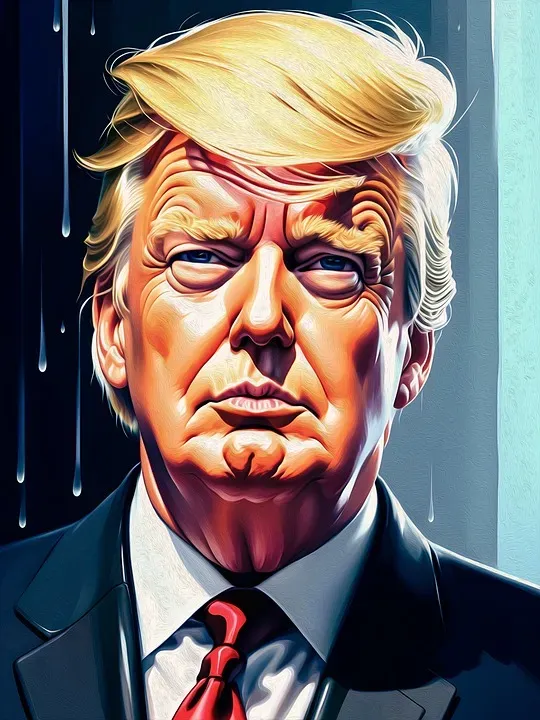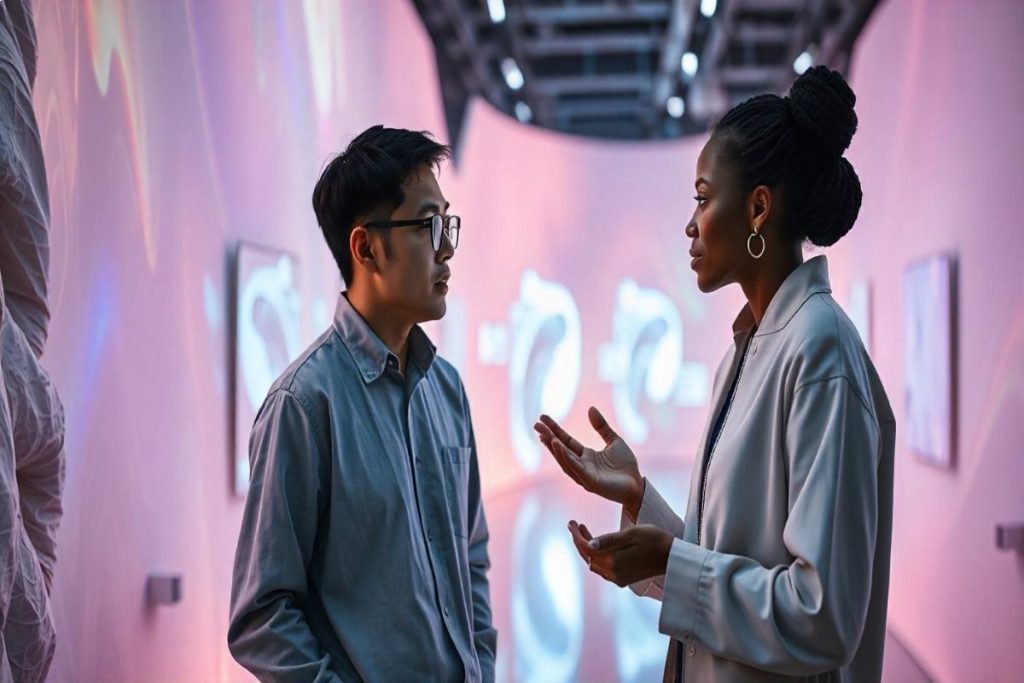Trump and AI-generated imagery intersect in fascinating ways that highlight the evolving landscape of political art and digital propaganda. Amidst the fervor of the Trump presidency, visual storytelling took on a new form as artificial intelligence began to curate politically charged images that resonated with his supporters. These AI creations range from glorified portraits of Trump to surreal representations that serve to bolster his narrative and influence on social media. As a result, the sphere of political imagery has bridged old-world artistry with modern technology, creating a unique amalgam that reflects Trump’s larger-than-life persona. This synergy not only captivates audiences but also raises critical discussions about the role of AI in politics and its implications on democratic discourse, especially as Trump’s favorability persists on platforms like Truth Social.
In the realm of digital media, Trump’s presidency has sparked a fresh examination of how artificial intelligence reshapes visual culture in politics. The tension between reality and representation is more pronounced than ever, as algorithmically generated images fuel an era of digital propaganda that often skews perceptions of political figures. This contemporary political imagery, much like a campaign collage, serves to amplify Trump’s messages, transforming them into shareable content that resonates with the public’s sentiments. As social media users engage with these striking visuals, they reflect not only admiration for Trump’s persona but also critique the underlying narrative driving their generation. Consequently, this evolution of political imagery invites us to consider the dynamics of influence and identity in an increasingly digitized political landscape.
The Political Imagery of Trump’s Presidency
Throughout Donald Trump’s presidency, political imagery has played a crucial role in shaping perceptions. The use of bold visual statements—such as A.I.-generated illustrations—has been emblematic of his public persona. This imagery often reflects his authority, as seen in digitally manipulated portrayals that position him as a larger-than-life figure, complete with symbols of power like golden crowns and muscular depictions. Such representations not only elevate his status but also contribute to a cult of personality that surrounds his administration, utilizing visual propaganda to reinforce his narrative among supporters.
The fascination with political imagery extends to how Trump’s visuals resonate on platforms like Truth Social and other social media. Here, the interplay between art and politics becomes evident through pieces that resemble classic propaganda. By creating an aesthetic that fuses realism with hyperbole, his supporters and hired artists craft images that resonate with a collective nostalgia and hero worship. Whether depicted as a wartime general or a modern-day titan, these images serve as tools for cultivating a devoted following, blurring the line between reality and artistic expression in political discourse.
AI in Trump’s Propaganda Tactics
The emergence of A.I. technology has profoundly influenced the landscape of political communication, particularly under Trump’s governance. Leveraging sophisticated image generation tools, Trump’s team has taken digital propaganda to new heights, crafting visuals that amplify his messaging while sidelining opponents. The rapid spread of A.I.-generated images has allowed the administration to flood social media with tailored content that underscores Trump’s ideals, asserting dominance in the digital realm. This approach not only serves immediate campaign needs but also actively shapes the narrative surrounding his presidency.
Furthermore, as A.I. continues to evolve, its integration into Trump’s strategy illustrates a shift in how political figures communicate with the public. By using machine-authored propaganda, Trump can curate an idealized image of himself—one that perpetuates his narrative without the human touch that might complicate his message. This technique has echoes of traditional political imagery, but it represents a step toward a future where human interpretation in media may be obsolete, leaving viewers to engage with a crafted reality devoid of authentic representation.
Trump’s Digital Persona and Social Media Influence
Donald Trump’s relationship with social media has been pivotal in constructing his digital persona. Platforms like Truth Social have emerged as key venues for him to communicate directly with his base, bypassing traditional media filters. This direct line allows for a unique interplay between user-generated content and official statements, where Trump can self-aggrandize through tailored narratives and striking visuals. His use of exaggerated imagery, often juxtaposed with crude symbols of power, further solidifies his appeal as a leader who exalts strength and dominance.
Moreover, the virality of Trump’s posts is accentuated by the proliferation of digital imagery—images that resonate with supporters’ psychological desires for recognition and power. By sharing A.I.-enhanced visuals or staged photographs, he fosters a shared identity among his followers, effectively turning them into an extension of his campaign narrative. This symbiotic relationship between Trump and social media underscores the evolution of political engagement, where imagery not only complements messaging but actively participates in the construction of a leader’s public identity.
The Aesthetic of Wealth and Power in Trump’s Imagery
A prominent theme in Trump’s portrayal is the aestheticization of wealth and power, manifesting through luxurious imagery and extravagant symbolism. As he embraces a maximalist style, Trump utilizes opulent visuals—such as gold fixtures and embellished decor—to project an image of success that resonates with his supporters. The emphasis on grandeur serves a dual purpose: it appeals to the aspirations of his base while simultaneously reinforcing the narrative of Trump as an embodiment of the American dream, albeit one rooted in consumerism and spectacle.
This aesthetic can be seen vividly in the way digital propaganda is crafted to emphasize Trump’s lifestyle and his tenacity. Through carefully curated visuals, such as images of him in lavish settings or with symbolically powerful artifacts, he conjures an illusion of invincibility. This portrayal not only elevates his status but also aligns with the political imagery of aspiration and fantasy that many Americans crave, making it a poignant commentary on the interplay of power, art, and political identity.
Jon McNaughton: MAGA’s Court Artist
Jon McNaughton, often described as MAGA’s ‘court artist,’ has become a significant figure in the realm of Trump’s political imagery. His paintings, which blend hyperrealism with a whimsical nostalgia, create a distinctive aesthetic that resonates with Trump’s base. By depicting Trump in fantastical scenarios alongside esteemed predecessors or in heroic poses, McNaughton feeds into the mythos surrounding Trump, transforming him into a larger-than-life figure revered within the conservative movement. His work highlights the powerful role art plays in shaping political narratives and the ways in which it can serve as both a personal tribute and a tool for mass communication.
However, McNaughton’s portrayals also reflect a trend in political imagery where the content becomes less about nuanced storytelling and more about reinforcing existing beliefs. The coloring and style of his paintings, akin to modern memes, make them highly shareable across platforms, enabling them to go viral among his supporters. This combination of traditional artistry with contemporary digital practices symbolizes how politics have evolved into an arena where visuals are paramount in engaging voters, demonstrating the impactful fusion of art and social media in Trump’s political strategy.
The Concept of Trumpian Aestheticism
At the core of Trump’s political persona is what can be termed ‘Trumpian aestheticism’, a concept reflecting the superficiality and style-over-substance approach seen throughout his administration. This aesthetic is characterized by sensational visuals, grandiose displays, and a relentless pursuit of admiration, often decoupled from the underlying principles of governance. As Trump curates an image of strength through exaggerated visual narratives, he effectively cultivates a brand identity—one that centers on wealth, power, and an unapologetic embrace of populism.
This aestheticism extends to how his supporters interpret his leadership, often viewing it through the lens of material success and visual representation. Thus, Trump’s presidency becomes less about policy and more about spectacle. The political imagery associated with Trump is not merely crafted for political campaigns; it represents a broader cultural phenomenon where superficial visuals can dictate public perception, challenging traditional notions of political identity and engagement in a digital age that favors style over substantive policy.
The Role of Digital Propaganda in Modern Politics
Digital propaganda has emerged as a formidable force in contemporary political landscapes, particularly during Trump’s presidency. With the advent of social media and A.I. technology, the ability to create and disseminate potent visual narratives has never been easier. Trump’s administration has adeptly harnessed these tools to propagate a consistent and powerful image, one crafted to resonate with specific ideologies and create emotional connections. This shift has transformed the nature of political discourse, where visuals often eclipse the dialogue surrounding policy.
The strategic use of digital images reflects a broader trend in politics: the growing importance of perception management over factual discourse. A.I.-generated imagery enables the rapid production of content that amplifies supporters’ beliefs while vilifying opponents, often blurring the lines between reality and fiction. This environment speaks to a fundamental shift in how political messages are conveyed, where the visual representation takes precedence, ultimately reinforcing the idea that in modern politics, style often trumps substance.
Trump’s Vision and the Aesthetic of Control
Central to Trump’s political strategy is what can be described as an aesthetic of control, where he uses imagery to assert dominance over narratives. This manifests in his selection of visuals that illustrate his vision of America, often depicting a sanitized, idealized society that aligns with his brand. The A.I.-produced images serve as both a literal and metaphorical extension of his desire to reshape public perception, often to the detriment of complex realities. Through these carefully curated visuals, Trump positions himself as the ultimate arbiter of truth, demanding that followers accept his vision as the defining narrative.
However, this aesthetics of control also invites critique. The singular vision that these images present often ignores the multifaceted nature of society, reducing complex issues to emotionally charged visuals. By projecting his worldview through hyperbolic imagery, Trump fosters an environment where debate is stifled, and dissenting voices are muted. This phenomenon reflects a broader concern about how political imagery shapes public consciousness and the implications it has for democracy in an age when digital manipulation is increasingly prevalent.
The Future of Political Imagery in an AI-Driven Era
As artificial intelligence continues to evolve, the implications for political imagery become increasingly significant. The capacity to create convincing visuals extends beyond traditional artistic means, giving rise to a new paradigm in which political figures can manipulate images with unprecedented ease. For Trump, this technological advancement offers new avenues for shaping public perception, ensuring that his regime can craft a narrative that suits its needs while controlling dissenting representation effectively. This development raises pressing questions about authenticity and the nature of representation in the political sphere.
The future of political imagery is likely to be dictated by these technological advancements, leading to a potential erasure of the lines between reality and image, truth and fiction. As seen with Trump’s case, the blending of A.I. capabilities with political strategy may come to define how leaders communicate with their constituents. This dynamic suggests a transformation in political engagement, where voters must navigate a rapidly shifting landscape of visual narratives, learning to discern the underlying truths within a burgeoning realm of fabricated imagery.
Frequently Asked Questions
How is Trump using AI-generated imagery in his political strategy?
Trump has leveraged AI-generated imagery to amplify his political messaging, creating a surreal digital persona that resonates with his base. By posting AI-enhanced visuals on platforms like Truth Social, he crafts an image of grandeur and power, showcasing scenarios such as conducting orchestras or triumphantly overshadowing urban landscapes. This approach allows him to control his narrative and present a polished version of reality, crucial for digital propaganda in modern politics.
What role does AI play in Trump’s digital propaganda efforts?
AI plays a significant role in Trump’s digital propaganda by generating eye-catching images that circulate online, enhancing his political brand. These visuals often depict hyperbolic scenes meant to evoke strong emotional reactions and reinforce loyalty among supporters. As a result, AI-generated imagery becomes a tool for maintaining his image and promoting his policies in a saturated digital landscape.
Can you give examples of AI-generated imagery related to Trump’s presidency?
AI-generated imagery related to Trump’s presidency includes fantastical depictions such as portraits of Trump depicted as heroic figures, or images where he appears in exaggerated power poses. These visuals often go viral on social media, resembling painted memes that reflect the exaggerated and nostalgic themes prevalent in MAGA art, effectively distilling complex political messages into simple, impactful visuals.
How does Trump’s aesthetic relate to AI-generated art?
Trump’s aesthetic aligns closely with AI-generated art in that both emphasize surface over substance. His preference for grandiosity and spectacle is mirrored in the often hyperreal, attention-grabbing images produced by AI algorithms. This synergy allows for the creation of imagery that is designed to be easily digestible and shareable online, enhancing his brand identity while appealing to emotions rather than critical thought.
What is the impact of AI in politics regarding imagery during Trump’s administration?
The impact of AI in politics during Trump’s administration includes a shift towards more aggressive and visually-driven communications strategies. AI-generated imagery has allowed for quicker dissemination of political ideas and narratives, enabling supporters to share content that reinforces their beliefs. This development contributes to a trend of digital polarization where imagery can be crafted to evoke specific emotional responses, further entrenching divisions within the electorate.
In what ways has Trump’s use of social media affected the portrayal of political imagery?
Trump’s use of social media has transformed the portrayal of political imagery by making it more dynamic and visually oriented. Platforms like Truth Social enable the rapid spread of AI-generated images that cater to his audience’s preferences, leading to a more aggressive use of digital propaganda. This has set a precedent for how political figures might utilize AI technologies to shape their public image and disseminate their message.
How does Trump’s imagery reflect his political messaging?
Trump’s imagery often reflects a politically charged messaging strategy that emphasizes strength, dominance, and a larger-than-life persona. Through AI-generated visuals that depict him as heroic or victorious, he communicates a narrative of triumph and superiority, which resonates with his supporters. This type of imagery serves not only to bolster his personal brand but also to align his followers with an ethos of empowerment and resilience against opposition.
What are the ethical considerations surrounding AI-generated imagery in Trump’s campaigns?
The ethical considerations surrounding AI-generated imagery in Trump’s campaigns include the potential for misinformation and the manipulation of public perception. The use of artificially created visuals can blur the line between reality and representation, raising concerns about authenticity and the potential for digital deception. Critics argue that such practices contribute to a media environment where visuals can easily mislead audiences, undermining democratic processes.
| Key Point | Description |
|---|---|
| Trump’s Aesthetic | His preference for grand, ostentatious displays of power is depicted in various forms of imagery, including A.I. art. |
| A.I.-Generated Imagery | The use of A.I. to create flattering representations of Trump showcases his desire for control over his public image. |
| Court Artists | Artists like Jon McNaughton create hyperrealistic and fantastical portrayals that resonate with Trump supporters. |
| Cultural Symbolism | Trump’s imagery often combines elements from various cultural artifacts, reflecting a maximalist aesthetic. |
| Public Perception | Trump’s use of A.I. imagery reflects his view of people as tools for enhancing his own narrative and power. |
| Manipulation of Reality | Trump’s administration employs A.I. and digital tools to reshape how reality is presented to the public. |
Summary
Trump and AI-generated imagery are increasingly intertwined, as Trump’s public persona leverages digital manipulation to craft a narrative of power and supremacy. This vitality of visual representation underscores a broader commentary on how political leaders can utilize technology to shape perceptions and influence followers, often at the expense of reality. As Trump continues to blend his ambitions with advanced graphic design tools, the line between reality and self-created imagery blurs, inviting a critical examination of authenticity in political discourse.



